Tomb of Hafez
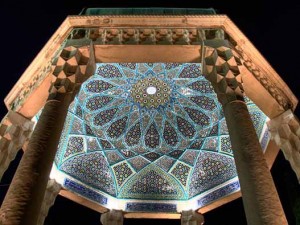
The Tomb of Hafez and its associated memorial hall, the Hāfezieh, are two memorial structures erected in the northern edge of Shiraz, Iran, in memory of the celebrated Persian poet Hafez. The open pavilion structures are situated in the Musalla Gardens on the north bank of a seasonal river and house the marble tomb of Hafez. The present buildings, built in 1935 and designed by the French architect and archaeologist André Godard, are at the site of previous structures, the best-known of which was built in 1773. The tomb, its gardens, and the surrounding memorials to other great figures are a focus of tourism in Shiraz.
Tomb of Daniel
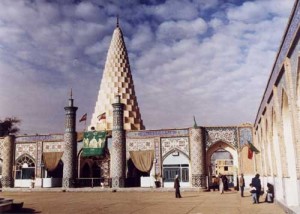
The Tomb of Daniel is the traditional burial place of the biblical prophet Daniel. Various locations have been named for the site, but the tomb in Susa, Iran, is the most widely accepted, it being first mentioned by Benjamin of Tudela, who visited Asia between 1160 and 1163.
Tomb of Cyrus
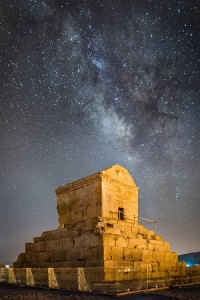
The tomb of Cyrus is a building of a small stone monument approximately 1 km southwest of the palaces of Pasargadae, According to Greek sources, the tomb of Cyrus the Great dates to 559-29 B.C. was located in the royal park at Pasargadae. The most extensive description* based on a lost account by Aristobulus. who had accompanied Alexander the Great (q.v,) on his eastern campaign in the late 4th century B.C., is to be found in the Anabasis of Arrian (6.29). written in the 2nd century A.D.
Tomb of Saadi Shirazi
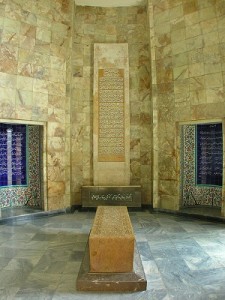
Abū-Muhammad Muslih al-Dīn bin Abdallāh Shīrāzī, better known by his pen-name Saadi, also known as Saadi of Shiraz, was one of the major Persian poets and literary men of the medieval period. He is not only famous in Persian-speaking countries, but has been quoted in western sources as well. He is recognized for the quality of his writings and for the depth of his social and moral thoughts. Saadi is widely recognized as one of the greatest poets of the classical literary tradition.
Today, his mausoleum is located in Shiraz.
Mausoleum of Attar Neyshaburi
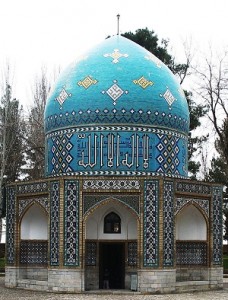
Abū Ḥamīd bin Abū Bakr Ibrāhīm (c. 1145 – c. 1221), better known by his pen-names Farīd ud-Dīn and ʿAṭṭār (“the perfumer”), was a Persian Muslim poet, theoretician of Sufism, and hagiographer from Nishapur who had an immense and lasting influence on Persian poetry and Sufism.
Today, his mausoleum is located in Nishapur. It was built by Ali-Shir Nava’i in the 16th century.
Tomb of Omar Khayyám Neishapuri in Nishapur
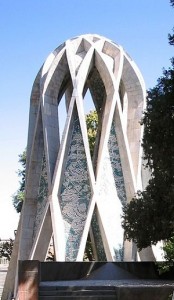
Omar Khayyám ; born Ghiyāth ad-Dīn Abu’l-Fatḥ ʿUmar ibn Ibrāhīm al-Khayyām Nīshāpūrī ( 18 May 1048 – 4 December 1131), was a Persian mathematician, astronomer, philosopher, and poet, who is widely considered to be one of the most influential scientists of the middle ages. He wrote numerous treatises on mechanics, geography, mineralogy and astronomy.
Omar Khayyám died in 1131 and is buried in the Khayyám Garden in Nishapur. The reconstruction of the tombs of Persian icons like Hafez, Saadi, Attar, Pour Sina and others were built by Reza Shah and in 1963, the Mausoleum of Omar Khayyám was reconstructed on the site by Hooshang Seyhoun.
Tomb of Baba Tahir in Hamadan
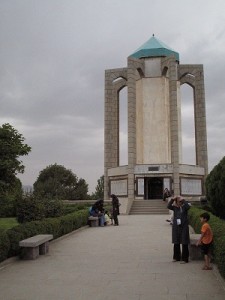
Baba Tahir (Baba Taher Oryan Hamadani) was an 11th-century Persian poet. His poetry is written in Hamedani dialect of Persian language. According to L. P. Elwell-Sutton he probably wrote in the local dialect, which “Most traditional sources call it loosely Luri, while the name commonly applied from an early date to verses of this kind, Fahlaviyat, presumably implies that they were thought to be in a language related to the Middle Iranian dialect Pahlavi. Roubène Abrahamian however found a close affinity with the dialect spoken at the present time by the Jews of Hamadan.” According to The Cambridge History of Iran, Baba Tahir spoke a certain Persian dialect.
His tomb, designed by Mohsen Foroughi, is located near the northern entrance of the city of Hamadan in Western Iran, in a park, surrounded by flowers and winding paths. The structure consists of twelve external pillars surrounding a central tower. It was reconstructed in 1970.
Mausoleum of Ferdowsi in Tus
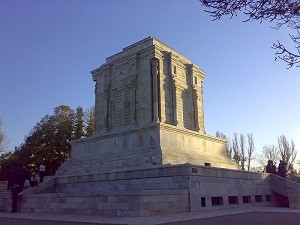
Abu ʾl-Qasim Ferdowsi Tusi (940–1020 CE), or Firdawsi, was a highly revered Persian poet and the author of the epic of Shahnameh (the Persian “Book of Kings”), which is the world’s longest epic poem created by a single poet, and the national epic of Iran and the Persian-speaking world. Having drafted the Shahnameh under patronage of the Samanid and the Ghaznavid courts of Persia, Ferdowsi is celebrated as one of the most influential Persian poets of all time, and an influential figure in Persian literature.
Ferdowsi was buried in his own garden, burial in the cemetery of Tus having been forbidden by a local cleric. A Ghaznavid governor of Khorasan constructed a mausoleum over the grave and it became a revered site. The tomb, which had fallen into decay, was rebuilt between 1928 and 1934 by the Society for the National Heritage of Iran on the orders of Rezā Shāh, and has now become the equivalent of a national shrine.
Kamal-ol-molk Mausoleum
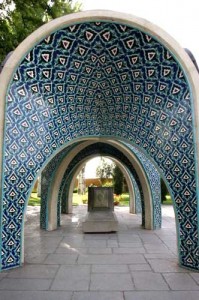
Mohammad Ghaffari, better known as Kamal-ol-Molk, was an Iranian painter and part of the Ghaffari family in Kashan.
Kamal-ol-Molk died in Nishapur, Iran, in 1940. Mournful people, especially family and closely related friends, marched his body next to the tomb of Sufi poet, Attar.
